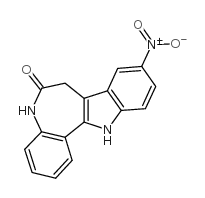
Alsteropaullone
CAS No. 237430-03-4
Alsteropaullone( 9-Nitropaullone | NSC 705701 )
Catalog No. M13686 CAS No. 237430-03-4
Alsteropaullone (9-Nitropaullone, NSC 705701) is a derivative of kenpaullone, ATP-competitive inhibitor of CDKs and GSK3β, inhibits Cdk1/cyclin B, Cdk2/cyclin A, Cdk2/cyclin E and Cdk5/p25 with IC50 of 35, 15, 200 and 40 nM.
Purity : >98% (HPLC)
 COA
COA
 Datasheet
Datasheet
 HNMR
HNMR
 HPLC
HPLC
 MSDS
MSDS
 Handing Instructions
Handing Instructions
| Size | Price / USD | Stock | Quantity |
| 5MG | 192 | In Stock |


|
| 10MG | 309 | In Stock |


|
| 25MG | 525 | In Stock |


|
| 50MG | 752 | In Stock |


|
| 100MG | 1035 | In Stock |


|
| 200MG | Get Quote | In Stock |


|
| 500MG | Get Quote | In Stock |


|
| 1G | Get Quote | In Stock |


|
Biological Information
-
Product NameAlsteropaullone
-
NoteResearch use only, not for human use.
-
Brief DescriptionAlsteropaullone (9-Nitropaullone, NSC 705701) is a derivative of kenpaullone, ATP-competitive inhibitor of CDKs and GSK3β, inhibits Cdk1/cyclin B, Cdk2/cyclin A, Cdk2/cyclin E and Cdk5/p25 with IC50 of 35, 15, 200 and 40 nM.
-
DescriptionAlsteropaullone (9-Nitropaullone, NSC 705701) is a derivative of kenpaullone, ATP-competitive inhibitor of CDKs and GSK3β, inhibits Cdk1/cyclin B, Cdk2/cyclin A, Cdk2/cyclin E and Cdk5/p25 with IC50 of 35, 15, 200 and 40 nM; exhibits specific antitumor activity against Group 3 medulloblastomas, causes inhibition of cell cycle-related genes, and down-regulation of MYC; inhibits the cytosolic degradation of β-catenin to alter the canonical Wnt signaling pathway in primary axis patterning, reduces tau phosphorylation.
-
In VitroAlsterpaullone (0.3, 1, 3 μM; 8 hours) induces apoptosis in leukemia cell line.Alsterpaullone (5, 10, 15, 20, 25, 30 μM; 48 and 72 hours) inhibits the growth of HeLa cells in dose-and time-dependent manner. Treatment with Alsterpaullone causes a time-dependent inhibition of cell growth too. Alsterpaullone (20?μM) induces cell death depending on caspase activity. Cell Viability Assay Cell Line:HeLa cells Concentration:5, 10, 15, 20, 25, 30 μMIncubation Time:48 and 72 hoursResult:The growth of HeLa cells was inhibited in a dose-dependent manner for 48?h and 72?h ranging from 0 to 30?μM.Apoptosis Analysis Cell Line:Jurkat cell line Concentration:0.3, 1, 3 μM Incubation Time:8 hours Result:Induced dose-dependent apoptosis. 1 μM was sufficient to cause apoptosis, 3 μM demonstrated maximal apoptotic effects.Western Blot Analysis Cell Line:HeLa cells Concentration:2, 4, 6, 12, 24 hours Incubation Time:8 hours Result:The cleavage of PARP started at 4?h, while the activation of caspase-3 occurred at 2?h.
-
In VivoAlsterpaullone (30 mg/kg, s.c., daily for 2 weeks) reduces tumor growth and increases survival in medulloblastoma xenografts. Animal Model:5-6 week old athymic nude mice Dosage:30 mg/kg Administration : Subcutaneous injections, daily for 2 weeks Result:Antitumor effect in Group 3 medulloblastomas.
-
Synonyms9-Nitropaullone | NSC 705701
-
PathwayAngiogenesis
-
TargetCDK
-
RecptorCDK
-
Research Area——
-
Indication——
Chemical Information
-
CAS Number237430-03-4
-
Formula Weight293.3
-
Molecular FormulaC16H11N3O3
-
Purity>98% (HPLC)
-
Solubility——
-
SMILESO=C1NC2=CC=CC=C2C(NC3=C4C=C([N+]([O-])=O)C=C3)=C4C1
-
Chemical Name7,12-dihydro-9-nitro-indolo[3,2-d][1]benzazepin-6(5H)-one
Shipping & Storage Information
-
Storage(-20℃)
-
ShippingWith Ice Pack
-
Stability≥ 2 years
Reference
1. Soni DV, et al. Cell Cycle. 2004 Mar;3(3):349-57.
2. Lahusen T, et al. Mol Carcinog. 2003 Apr;36(4):183-94.
3. Schultz C, et al. J Med Chem. 1999 Jul 29;42(15):2909-19.
4. Faria CC, et al. Oncotarget. 2015 Aug 28;6(25):21718-29.
molnova catalog



related products
-
Palbociclib (PD03329...
Palbociclib (PD0332991) Isethionate is a highly selective inhibitor of CDK4/6 with IC50 of 11 nM/16 nM.
-
PF07104091
PF-07104091 inhibits CDK2, which may lead to cell cycle arrest, induce apoptosis and inhibit tumor cell proliferation.
-
VMY-1-103
A novel dansylated analog of purvalanol B, and a CDK inhibitor that inhibits cell cycle progression and proliferation in prostate and breast cancer cells more effectively than purvalanol B.



 Cart
Cart
 sales@molnova.com
sales@molnova.com


